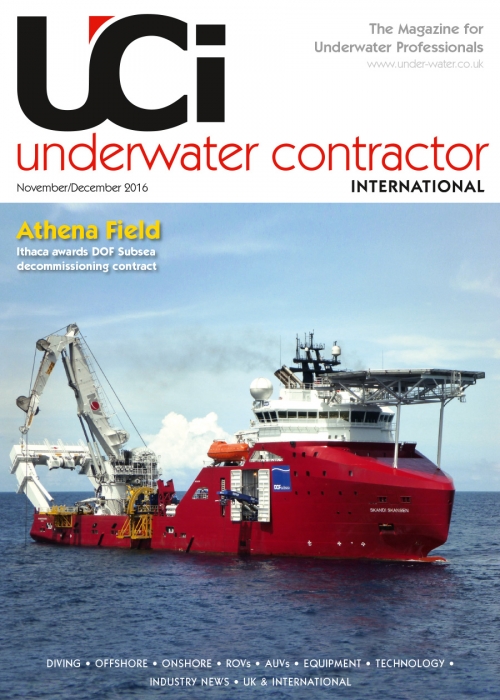
The Magazine for Underwater Professionals
![]() Nov/Dec 2014
Nov/Dec 2014
TRAINING
Commercial diver training returns to Cornwall
Michael Cocks pays a visit to Commercial Diver Training Ltd in Cornwall
Michael Cocks and Dr Maarten Van Kets prepare to dive with Cornwall-based Commercial Diver Training Ltd
Earlier this year I received an invitation to visit a new commercial diving school in Cornwall, UK, from George Gradon, whom I had met some years ago at Bovisand. After three years of planning, Commercial Diver Training Ltd (CDT) was set up by George and Warren ‘Sal’ Salliss, who are partners in a commercial diving company.
George spends some time as an active saturation diver with Subsea 7 and Sal, having spent 15 years in the Royal Marines, is now qualified as a commercial diver. They are joined by Sal’s wife, Tamsin, who is also a qualified commercial diver.
WORKING
The instructors are experienced working divers and the equipment is the most modern. For its Surface Supplied Diver course, the school operates mainly from the Hambledon, a former Admiralty fleet tender, which has accommodation for 12 students and staff. Diving takes place around the harbour of Fowey and for two weeks at the end of the course, mainly for deeper dives, out of the Mayflower Marina in Plymouth. The nine-week courses run from March to October. Since my visit, a second fleet tender, Loyal Watcher, has been bought; its primary purpose will be for the school’s Professional Scuba course and it has accommodation for 16.
The Surface Supplied Diver course is one of the most intensive I have seen and students have to have a basic scuba qualification before being allowed on the course. They are encouraged to take part in a two-day aptitude test to see that they are happy working underwater in full commercial gear, for up to an hour. I paid two visits to the school and on the second visit there were 10 students, who had all joined after checking in advance the quality of the training.
The first four weeks of training are spent on professional scuba training (mainly media, scientific and archaeological) with tasks developed with local academic and historical bodies. Diving takes place in various locations within Fowey Harbour and the open sea. For the final week on this part of the course they dive in band masks.
SPLIT
They then spend four weeks diving in surface supply equipment, with the diving split between Fowey’s sheltered harbour and Plymouth’s deepwater. The course is based around a wide variety of inshore/marine civil tasks, including the use of a range of hydraulic and pneumatic tools, surface and underwater welding and burning and general construction tasks.
CDT’s one-week Offshore Top Up course is also carried out in Plymouth. Students complete dives from a wet bell, using hot water suits, and undertake a number of mid-water tasks. Surface umbilical and bell umbilical management systems are also covered during this final module of CDT’s nine-week programme.
LEARN
I was pleased to learn that dives can last up to 90 minutes and a variety of tasks are given for the students to carry out. In Plymouth they do two 45-metre dives and on the second have to ascend up a shot line, with a 30-minute in-water stop. This compares well with my training dive in a hot water suit and wet bell, spending only 10 seconds at 50 metres. I have long argued that students should be subjected to what I loosely describe as “controlled stress”. Some of the Plymouth dives are out of a wet bell. All the equipment is the most modern and out of the course fee students are provided with a dry suit and other equipment.
On my first visit I was accompanied underwater by my commercial diving doctor, Maarten Van Kets, who qualified as an HSE Part 1 Offshore Diver in 1997. On our dives we used modern hot water suits and KMB 37 helmets. In Fowey I was accompanied by a student, Zac Hollis, who was to do some cutting. As I have said, students have to undertake a wide variety of tasks at different destinations around Fowey Harbour, including underwater surveying of a variety of vessels. I was impressed by the quality of students and pleased to learn most of the previous trainees have found work. It is not easy for a new school to be set up; at one stage we had seven training establishments in Britain, so it is good to see that commercial diver training in the United Kingdom is on a firm footing again.
PERFORM
This visit was my 40th to a commercial diver training school around the world. I never describe myself as a working commercial diver but think I have enough common sense to judge what students need in their training. It is vital during training that they use the most modern equipment and are given challenging tasks to perform. On my second visit I was particularly impressed as to how the 10 students worked as a team and took the utmost care in looking after me.
It was good to see commercial diver training return to my home county, Cornwall, and also to find that the very small village of Kelynack, my third christian name, is now on the tourist map. I was particularly pleased to be able to dive with my commercial diving doctor, who performs very thorough general medical check-ups on me, as is certainly needed as I pass my 78th birthday.


